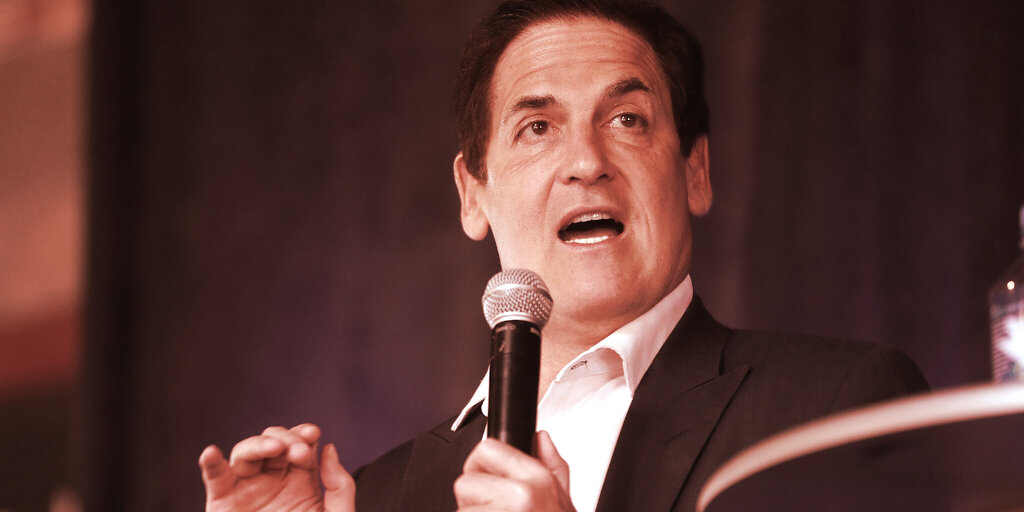In summary
- The billionaire NBA team owner, Mark Cuban, hasn’t gotten tired of NFTs lately.
- He told Decrypt that the key to understanding the NFT craze is “getting over that realization that I have to be able to touch it physically”.
The Dallas Mavericks owner and investor in ABC’s “Shark Tank”, Mark Cuban, never tweeted the term “NFT” until January 27 this year. But since then, he has tweeted a cascade of links to his own NFTs or non-fungible tokens, blockchain-based collectibles that have exploded in popularity (and price) in sports, music and art.
Cuban went crazy because of that: he promoted NFTs in NBA Top Shot, Rarible, Mintable and OpenSea, different platforms to buy, trade and share his NFTs.
It is a difficult phenomenon to understand.
Cuban, in an extensive interview this week with Decrypt, explains this by holding his own favorite basketball card: John Brisker, who played in the 1970s for the hometown of Pittsburgh Condors, at ABA, before leaving the league to become a mercenary in Uganda, where he disappeared in 1978. (“Cool story like hell, “says Cuban.)
The fun of owning the card is “just the joy of owning it,” says Cuban. “I don’t shoot and see it all the time. John Brisker’s picture, you can find it online somewhere, there’s nothing unique and it’s not like the picture is a work of art, and there’s nothing special about statistics and the comment on the back. Everything that is available online. It is the property that comes with it. And because you have it physically, this is your only proof of ownership. “
The ‘joy of ownership’
If Cuban wanted to sell the card, he says, he would have to start an intensive process: validate, evaluate and price a professional, wrap it up, send it to the buyer and get paid.
NBA Top Shot comes on the scene, the market where fans and collectors buy digital video clips of, say, a LeBron James dunk and can share, keep or sell them. In the past 30 days, it has reached almost $ 300 million in volume. On a busy February day, the platform sold $ 2.6 million in NFTs in 30 minutes. Collectors are paying hundreds of thousands of dollars, in some cases, for a one-piece digital video clip that you can also watch on Twitter, Instagram or YouTube.
You have to “get over this realization that I have to be physically able to touch it,” says Cuban, “and realize that this is more uncomfortable, the joy of ownership is really what matters. You get all the benefits of the joy of ownership. .. all value creation – or loss, by the way – friction-free trade and transactions, the ability to pay royalties to the original creator after each sale, which is huge and really allows more creativity to reach the market. Who drew [the card of] good old John Brisker and took a picture of him is not getting any value. “
Overcoming the feeling of wanting to physically hold the art you bought is easier said than done, although anyone who believes in Bitcoin as an investment has already, at least partially, understood the idea of the Internet of Value.
And even if you buy the Cuban pitch for NFTs, the technology can be intimidating. NBA Top Shot is on Flow, a blockchain faster than Ethereumand allows buyers to pay in dollars, so they don’t necessarily have to deal with encryption or even think about encryption. (Top Shot has another thorny problem at the moment: buyers have complained that it is difficult to get their money off the platform.)
But Cuban’s statement about the possibility of paying royalties to the original owner is the part that caught the artists. The fact that Kings of Leon transformed their new album into three varieties of NFT may suggest that there is something permanent here.
‘It’s not as private as people think’
There is another problem with NFT ownership. When you publicly share a link to your NFT wallet on a platform like Rarible, anyone with a basic knowledge of blockchain can view the wallet’s address on Etherscan (a public website to view the Ethereum blockchain) and view the monetary content of their wallet . (The Bitcoin blockchain is the same way: charged as anonymous, but actually more as semi-anonymous.)
Cuban cheerfully tweeted his Rarible wallet, and on Friday afternoon, that wallet contained $ 455,000 in tokens and NFTs.
Cuban knows that everyone can see that and he doesn’t care. (He also suggests, “I have a lot of wallets. I have a lot of wallets.”) But does a celebrity like Lindsay Lohan, who also tweeted her Rarible address, notice this? (Hers now has only $ 440.)
“Yes, it is not as private as people think,” admits Cuban, laughing. “And that is the main point of the blockchain, right? That it is 100% public because it is all verifiable. But of course, I could just take everything and put it in another wallet … And for me, 99% of what I am doing now it’s just learning. Learning how pricing mechanisms work, learning how transfer technology works, learning how to coin, learning to post, it’s all part of a learning curve. that, celebrity or not, anyone can do. “
